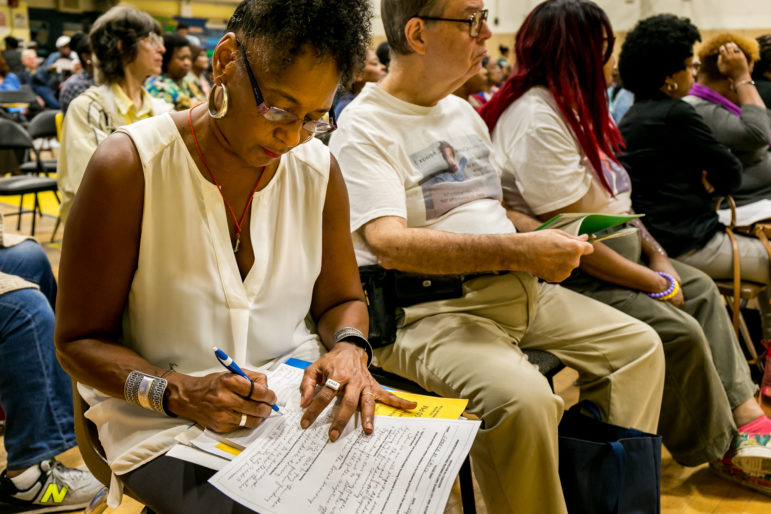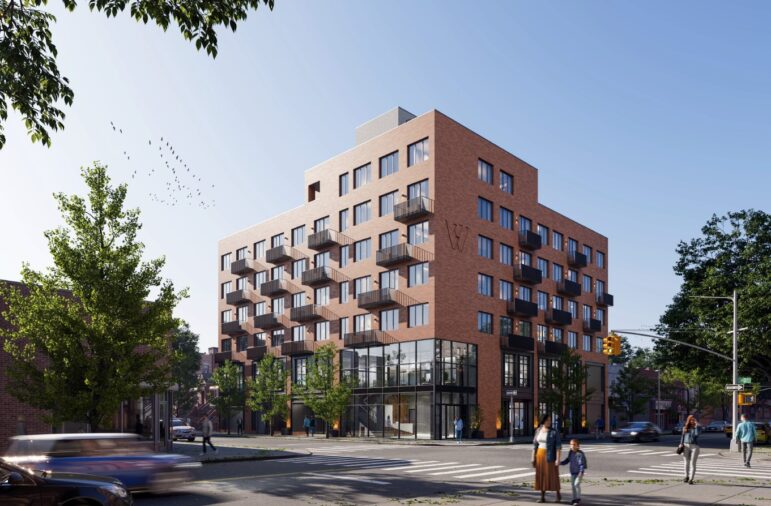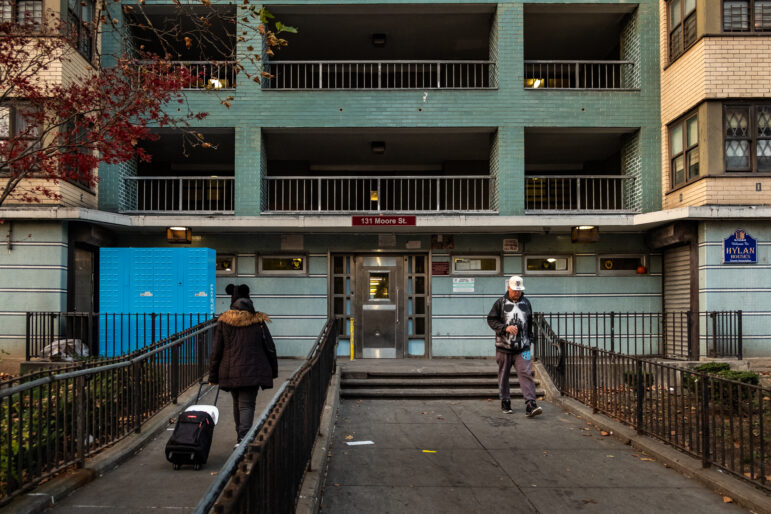
Adi Talwar
Coalition member Dr. Sharon Cadiz said residents can see recent examples of how community action can reshape development decisions in Maspeth and at LIC's own Phipps Houses site.
Nearly 300 people packed the Jacob Riis Neighborhood Settlement House in Long Island City on Monday night to discuss the de Blasio administration’s plan to rezone the area.
Hosted by the Justice for All Coalition, an alliance supported by Faith in New York and consisting of local labor, church, and public housing tenant groups, the forum sought to inform local residents about the stakes of a potential rezoning and share the coalition’s platform of demands for future equitable development.
“We came together…to pull our community together to say, ‘look, you can’t build in Long Island City and build what you want to build. Long Island City is not for sale,” said Dr. Diane Brown, an elder of a local church and chairwoman of the coalition.
Though de Blasio named Long Island City as a potential site for upzoning in his February 2015 State of the City address, the administration has yet to initiate any public planning process in the neighborhood, and has yet to provide any specific details about what kind of rezoning they will propose. That has left members of the coalition baffled, but also given them plenty of time for grassroots organizing.
The diverse audience at last night’s forum included residents of Queensbridge Houses, Astoria Houses, Ravenswood Houses and the surrounding neighborhoods.
Cathy Dang, executive director of CAAAV and a member of the Chinatown Working Group, explained the efforts of Chinatown and Lower East Side groups to form their own rezoning plan as a potential model for Long Island City stakeholders. Both neighborhoods have hot real estate markets, large public housing developments, and a substantial low-income population.
“We’ve been engaged in it for eight years, eight years to come up with a 150-page really clear and concise document of what we want to rezone Chinatown and the Lower East Side. We’re finally at a point where we’re beginning negotiations with City Planning,” said Dang. “When we started the plan we had three basic principles: number one, self determination—people who are directly impacted have to choose [what’s] in the plan… number two, any changes that happen in the neighborhood have to account for the long-time residents who make it what it is.”
Yet, as coalition member Dr. Sharon Cadiz reminded the audience, residents can also look locally to find examples of resident organizing against the administration’s housing plans. Just last month, Sunnyside residents convinced Councilmember Jimmy Van Bramer to shoot down a plan by Phipps Houses for a rent-restricted development that some residents said would be too tall and lacked deep enough affordability. After residents in Maspeth protested against de Blasio’s plan to convert a hotel into a homeless shelter, the administration modified their plan last week.
As the councilman for Long Island City, Van Bramer will have the ultimate say on the potential rezoning of the neighborhood. His deputy chief of staff Andres Villas attended the forum and described the councilman’s recent “back and forth” with the administration as evidence of Van Bramer’s attentiveness to constituents’ concern about development.
“A rezoning is not only something that should worry you, but worries our office,” said Villas.
Frustrations with past rezonings surface
Long Island City residents have first-hand experience of how market-rate development can change the character of a neighborhood. The neighborhood was the target of a Bloomberg administration rezoning in 2001 that lead to the creation of over 10,000 new housing units, in addition to the rezoning and wholesale redevelopment of the waterfront.
Audience members clapped and nodded as coalition members described how past rezonings of Long Island City failed to create sufficient numbers of union jobs, local hiring opportunities, and truly affordable housing, all the while forcing rents to rise and displacing affordable stores. Audience members mourned that a C-Town on Broadway and 29th Street will be replaced with a more expensive Food Emporium as part of a housing development project, as reported by DNAinfo this month.
One speaker described her frustration at applying for affordable housing at the nearby Hunter’s Point development site and receiving no response to her application. Another described how she could not afford an apartment to accommodate her aging mother and had to send her to a nursing home in Florida.
“It’s not going to be pretty to have to send your family away and have to leave the community you call home,” said Mayra Mercado, a resident of Astoria.
While many of the neighborhood’s low-income residents reside in public housing and are therefore protected from rising rents in the private market, they still struggle with rising costs of living and have increasingly few options to move out of NYCHA, Faith in New York’s Andrew Hausermann told City Limits. In addition, complying with a federal mandate, NYCHA has increased rents in recent years, though, according to the housing authority, no family will ever pay more than 30 percent of their income on rent.
Yet recent changes to the way NYCHA does business—from its leasing of underutilized property to private developers, to its transfer of some public housing complexes to developers under the federal Rental Assistance Demonstration (RAD) program—has also lead to the perception that public housing residents are next in line to be displaced. While they might raise other concerns, neither program would result in the direct displacement of residents.Yet fears about “privatization” were palpable at the forum, with one tenant association leader for Queensbridge Houses warning residents that NYCHA would sell their complex to a developer and that they would be priced out by ensuing rent increases. NYCHA spokesperson Isaac McGinn said in an e-mail to City Limits that such rumors were “patently false.”
“Every step we are taking under NextGeneration NYCHA, the Authority’s ten-year strategic plan, is to prevent the abandonment of public housing that has occurred in other cities. Residents can rest assured these claims are completely untrue and baseless,” said McGinn, adding that the de Blasio administration has invested millions of dollars in improvements at Queensbridge and that there were no privatization deals underway.
It is true, however, that the city is developing land at Astoria Houses with a school and housing for families making 60 percent AMI ($54,360 for a family of 4), a project started by the Bloomberg administration. 50 percent of the total units will be reserved for NYCHA residents from developments throughout the city.
Coalition demands deep affordability, local jobs
The coalition asked the audience for feedback on a draft list of principles for an equitable rezoning. Of the housing created by a rezoning, the coalition says that 10 percent should be set aside for the homeless, 30 percent should be for residents making between 25 percent and 60 Area Median Income (AMI) or $21,575 to $51,780 for a family of four, and 10 percent should be for middle-income families making between 60 and 100 percent AMI ($51,780 and $86,780 for a family of four). The coalition also lists a number of anti-displacement strategies to preserve existing affordable housing, such as the creation of a tax credit for owners of small buildings that continue to provide affordable housing, and the passage of Intro 214, creating a legal right to counsel in housing court.
The coalition wants 30 percent of construction jobs generated by the rezoning and 50 percent of permanent jobs in the hotel and retail industries to be set aside for local residents, and for developers to offer goods wages and union apprenticeship programs. They also want investment in local businesses, including manufacturing facilities, and support for the creation of new businesses and worker cooperatives. Other rezoning neighborhoods have made similar economic demands, but while the de Blasio administration has offered those neighborhoods resources for workforce development and support for small businesses, it has so far shied away from tying labor requirements to land-use applications.
The coalition is determined to ensure “the needs of public housing are put at the center of the conversation and process around rezoning,” and demands timely repairs of existing NYCHA apartments and that public-housing residents be given a solid chance to get some of the new units created through development.
The coalition also calls for a commitment to real community engagement in the upcoming planning process, with substantial pre-notice of official meetings and clear publication of stakeholders’ comments on the plan. Last but not least, it demands infrastructure investments including improvements to green spaces, transportation, initiatives to protect the waterfront from climate change, and that the city ensure the proposed Brooklyn Queens Connector (BQX) streetcar truly serves residents of public housing.
Brown said that in addition to working to ensure a future rezoning reflects their principles, the coalition will fight for deeply affordable housing in development projects that are currently underway.
Many elected officials, including members of the de Blasio administration and others, were invited but did not attend the meeting.
Residents of Long Island City and Astoria who would like to become involved in the Justice for All Coalition’s fight for an equitable rezoning are invited to monthly meetings at the Community Church of Astoria at 14-42 Broadway. The next meeting will be November 14 from 7 to 8:30 pm.










One thought on “Awaiting a City Plan, LIC Groups Sketch Out Red Lines Around Rezoning”
Pingback: “Awaiting a City Plan, LIC Groups Sketch Out Red Lines Around Rezoning” | 唐人街關注組 Chinatown Concern Group